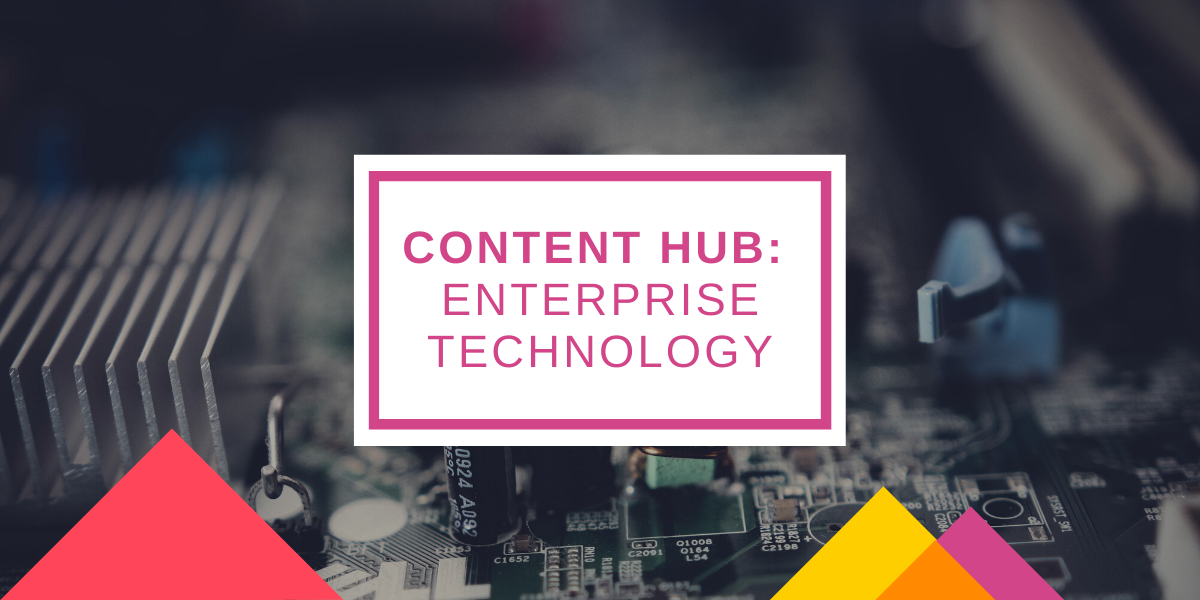The only constant in the world of enterprise technology is change. Never has that statement been more true than right now, as businesses across all industries fight to stay on the digital front foot. While this presents opportunities for vendors, it also makes it harder than ever to be heard. This guide contains the insights and advice enterprise technology brands need to make their mark through public relations and marketing.
- How can enterprise IT brands engage a global audience?
- The importance of localizing b2b marketing messages
- Key steps for any enterprise technology rebrand
- Third-party recognition: how to gain b2b credibility
How can enterprise IT brands engage a global audience?
Growing an enterprise IT brand globally has never been an easy task. Businesses have faced the perennial challenge of standing out from the crowd and engaging their audiences around the world in the most effective way possible.
The bad news is that this has quickly become more complex than ever before. Not only is there now more competition, there’s also a wider variety of channels to consider. Throw in the fact that COVID-19 has dramatically reduced the opportunities salespeople have to meet prospects and customers face-to-face, and it’s clear that enterprise IT brands have a serious task on their hands.
So, in an increasingly remote world, how can you maximise the effectiveness of your global PR and lead gen campaigns? How can you generate leads and drive brand awareness by reaching the right audience, with the right content, at the right time?
Adapting to different regions
This is where PR and content marketing campaigns play a key role. But, when you’re targeting people in different countries around the world, a one-size-fits-all approach simply won’t cut it.
Asia-Pacific provides a perfect example of the importance of customising campaigns to different countries. Kunalan Chakravarthy, CEO of Singapore-headquartered communications agency Priority Consultants, explains: “Too many fall into the trap of treating all countries in APAC the same, rather than considering the vast cultural differences between them. Businesses have to be prepared to create specific PR and marketing plans for each country if they want to make a real impact in the region.”
It’s vital to appreciate the differences between countries – even those that are culturally similar – as this will impact the success of PR and lead gen campaigns. “UK enterprise IT outlets are interested in strong opinions, relevant data points and customer references,” says the lorries’ UK director Hannah Patel. “But remember that all content must resonate with a UK audience. Just because we speak the same language as the US, it doesn’t mean a one-size-fits-all approach will work.”
Clearly, there’s a huge amount to think about when it comes to generating leads and building brand awareness remotely. So, we’ve gathered expert regional insights from our global PR network, Convoy, to help you navigate your way through the needs and nuances of local markets, cultures and media landscapes.
Click here to download your free copy of our enterprise IT myth-busting eBook.
The importance of localizing b2b marketing messages
As a b2b marketer, you want to get your company’s message out to your target audience as effectively as possible. Your message should encourage (or even inspire) your audience to act – whether it be to attend an event, join in a conversation, or better yet, buy your product.
This can be a particular challenge for enterprise technology brands that have a presence in multiple different countries or regions. After all, how well will your message resonate if it’s not presented in a language that your target audience will understand? The obvious answer is: not very well, if at all! That’s why the key to delivering a clear, actionable message is localization.
It’s not always what you say, but how you say it
With so much competition in today’s enterprise technology landscape, it’s vital that brands connect with consumers wherever they are, which means they have to consider different languages, cultures, and traditions.
By using localization, you will be able to adjust your message to fit the needs (and understanding) of your audience. This could be as simple as making sure that your product name doesn’t include slang or poorly translate into another language.
And, despite the global economy we know today, localization is still extremely important for enterprise technology brands. For example, research has found that 75% of consumers prefer to buy products in their native language.
What are the benefits of localization?
- Promotes understanding – by presenting your marketing message in a local fashion, you’re showing your target audience that you understand what they’re interested in and how they communicate.
- Builds brand recognition – localized marketing will be more understood than general marketing. Giving your brand a local feel will result in it being more recognizable, so it will stand out among the competition in your field.
- Establishes trust – by speaking to your target audience in their preferred language, you’re telling them that you understand their needs and are able to provide solutions that they can understand.
- Welcomes interaction – think of presenting your customized content as an invite to your audience – if they can read it and understand it, then they’ll act on it. If it’s confusing or hard to digest, it’ll be tossed aside like junk mail.
Of course, not everyone gets it right. Globalization blunders are prominent worldwide, and while they may be humorous, they can also be offensive. And offending your target audience should never be your goal – or that of any enterprise technology brand. Localization gives you the power to customize your message so it’s not only understandable, but also appealing to your target audience.
As you plan your marketing campaign, be sure to not only research who you want to reach, but also what their preferred language may be. For example, Spanish is spoken in many countries, but residents in Mexico, Puerto Rico and Spain are all not the same and each group should be addressed individually. A b2b message that sounds perfectly sane in one language, maybe downright offensive in another. By researching your target audience’s preferred language, you’re saving yourself and your organization the shame of committing a misstep.

Suggested Post
Five brand globalisation blunders to learn from
Product names and taglines don’t always translate the same in other regions, which is why transcreation is important for brand...
Read MoreHow do I go about localizing my marketing messages?
Before jumping in headfirst, take a step back and consider what it is you want your target audience to do. Are you having a webinar that’s important for b2b enterprise technology executives? Or do you want to increase your channel awareness in a specific region? Localizing both of these may be crucial to your campaign’s success, but need to be handled differently depending on the country, region and language.
It’s also vital to do your research. In-depth market research can help you determine what is deemed appropriate in your target area. Be sure to not skip this step – it can be time consuming, but is worth its weight in gold. Without first researching cultural proprieties, how can you know that your message will be received as intended?
This sounds complicated…
Well, it can be. That’s why it’s best to partner with b2b marketing and PR agencies that offer professionals on the ground in your target countries and – most importantly – in the markets you want to reach. Those agencies will be able to provide vital local insights that can help inform the wider marketing strategy, whether that be enterprise technology or any other sector.
By utilizing a local teams’ knowledge of the market, you’ll be better able to deliver your message concisely and drive your campaign to the audience you want to reach the most.
Don’t let localization challenges keep you from delivering your b2b marketing message. The lorries and our global PR partner network Convoy are happy to assist! Drop us a line at hello@rlyl.com and we’ll help you get your marketing message out clearly and confidently.
Key steps for any enterprise technology rebrand
Have you ever wished that you could change the way your enterprise technology brand is perceived by others? It’s the classic “grass is always greener” effect – perhaps a change of eye or hair color, or a body switch that could present you as an entirely different person to the world (hey, it worked in Face/Off and Big). While there’s access to contacts and hair dye for people looking to make a change, achieving a perception shift in marketing isn’t always as easy.
Marketers need to make sure that their enterprise technology brand stands out from the rest – something that has become harder and harder to do as the level of competition in the industry has continued to increase. This could mean taking a stance to support a social cause or even rebranding the entire company. But one thing no enterprise technology company should never do is forget about how any change could affect its target customers.
Coca-Cola learned this the hard way when it tried to rebrand its famous soda as New Coke in 1985. The backlash was immediate and harsh – and taught company marketers that change isn’t always welcome. However, Coca-Cola took the criticism, reexamined the company, and then presented a new drink – Coca-Cola Classic – which continues to prop up its position as one of the most valuable brands over 30 years later.
Before going through an enterprise technology brand change to alter the image and/or messaging around the company or product, it’s important to:
- Keep the messaging consistent and concise: It’s crucial for any enterprise technology brand to keep its messaging consistent across the board. Straying too far from the core values of a company can confuse customers and potentially drive them away. Confusing your buyers with messaging full of jargon and IT buzzwords is a surefire way to reduce your sales, while keeping your message clear and understandable is one of the best ways to maintain healthy relationships with customers.
- Understand the buyers: What’s the use of selling to a cultivated list of customers if you’re not offering what they want and need? Before making adjustments to messaging, remember your audience. Know who you’re targeting and then create a plan that communicates clearly how your product delivers what they want and treats their pain points.
- Test your message: The budget is approved, the concept is final, and all seems well – but has the messaging been tested? Before giving the green light on any enterprise technology brand campaign, it’s important to gauge how it will be received. Utilizing test groups and A/B testing can help marketers figure out what’s perceived as a strong brand message and what messaging might miss the mark.
- When it doubt, cut it out: If you’re not sure your message will work, don’t execute the plan. It’s far easier (and more cost-effective) to pull the funding on a campaign you’re not sure about than to potentially spend millions cleaning up a mess.
Once your brand change is ready to go, don’t forget to share the new messaging across all channels. This includes targeting key media and analysts, sharing on social feeds, and investing in digital campaigns (like pay per click (PPC) and by targeting specific audiences using LinkedIn Sales Navigator and GoogleAds). These activities can play a key role in ensuring a successful brand repositioning, as a strong integrated marketing program that supports your new branding will enable you to successfully reach a wider range of audiences.

Suggested Post
PR tips for companies going through a rebrand
What do BackRub and Jerry’s Guide to the World Wide Web have in common? They’re both former names of two of the biggest...
Read MoreRemember, in the face of so much competition, going through a branding change can be hugely beneficial for enterprise technology companies. However, with a myriad of challenges facing today’s marketing professionals, it can also be extremely complex. That’s why simple steps like putting in the time to research target audiences (including their needs and how your offering can help them) and testing your messaging before executing any campaign can be worth their weight in gold.
Are you looking for a fresh perspective on your b2b brand campaign plan? We’d love to help – email us at hello@rlyl.com or visit our contact page.
Third-party recognition: how to gain b2b credibility
By Alex Rabone
Third-party recognition is a major factor for any customer thinking about buying into an enterprise technology business. It provides assurance that you, the business, can provide the product or service that you say you can. It also establishes trust. Why do you trust brands like Apple to make you a working phone? Because millions of people have trusted them to do just that for years.
It’s exactly the same in the b2b world, particularly for enterprise technology companies. Without third-party recognition, businesses aren’t going to flock to a cybersecurity firm just because it claims to be able to protect customers from all cyber-attacks. It sounds too good to be true, so you have to prove it.
In order to gain industry recognition from third-parties, it’s vital not to oversell what you’re capable of. E.g. don’t say you can solve every type of cyber-attack if you can’t. This is important because potential customers will look to current customers’ or impartial third-parties’ opinions to determine if they can trust an organisation.
This trust needs to be built over time and it isn’t always easy. So, we’ve outlined three ways enterprise technology companies can establish third-party recognition to not only help build their organisation’s reputation, but also assure potential customers that they – and the product or service the offer – can be trusted.
1. Customers
Customers are a brand’s biggest advocate. They have first-hand experience with the business and can attest to other potential customers that the product or service is effective in what it’s designed to do. There are a number of ways to show off customers and their endorsements in order to capture some recognition in the industry.
For example, it’s common for enterprise technology businesses to list their customers’ logos on their website. It’s a simple and effective way of highlighting a number of organisations that trust the brand and its products. It’s usually accepted that the more notable the customer, the bigger impact it’ll have on the website, but they all count. It shows that a customer has been satisfied by the business relationship and garnered benefits from it.
But don’t stop there, as a couple of recognised brands probably won’t do anything more than draw a customer in. You have to argue your brand’s case and an excellent way to do that using customers, is through customer case studies.
These allow brands to demonstrate the impact that they’ve had on their customers. Whether it’s how cloud migration has transformed a business’s operations, or how a new technology has reduced fraud for a challenger bank, customer case studies offer potential new customers valuable insight and in-depth analysis of the real-life benefits on offer.
Sometimes it can be challenging to persuade customers to take part in customer case studies. Some don’t want to give away any secrets, in which case testimonials can offer a much easier way to get buy-in. They aren’t as intrusive as case studies and provide a much more personal touch than just a logo on a website.
The biggest takeaway should be that your customers can be hugely valuable. You don’t book a hotel with no reviews over another with 100 great reviews and it’s the same in b2b. The enterprise IT space is hugely competitive and companies will feel more comfortable doing business with someone if they see other companies advocating the work. There are always effective ways of utilising customer relationships.
2. Speaking opportunities
In b2b PR, establishing good media relations is critical to helping clients build their thought leadership presence. This has to be done through a continuous effort aimed at getting the company’s content and messaging coverage in the media and, most importantly, in front of the right readers.
As spokespeople begin to establish themselves in the industry, speaking at industry events offers a great way to solidify them (and in turn, the company) as a thought leader.
These opportunities help establish credibility in front of a captive audience, showing that event organisers trust, and industry professionals want to hear, what your business leader has to say. It can be difficult to accurately establish who reads specific publications, but at industry events you know you’ll be able to get spokespeople in front of a relevant crowd of potential customers – especially those that are geared towards specific aspects of enterprise IT.
Discussing customer case studies in relation to key trends in the industry shows off how your business is capable of solving problems, overcoming key industry challenges or helping businesses grow.
3. Awards
Winning competitions to prove that you’re the best at something is so ingrained in human nature, it’s been going on for centuries. In this sense, the world of b2b PR and marketing is no different to the ancient Greeks (albeit less dramatic).
Every year there are a number of enterprise IT awards available, ranging from the broad and project-based to the niche and solution-based categories. Winning awards provides compelling evidence to potential customers that a select committee of knowledgeable experts has agreed that your product or service is the best among its peers. It could be the deciding factor in whether a business selects your company, or a rival.
Unlike speaking events and media relations, where content is mostly designed to push spokespeople and their companies as thought leaders, awards are based on real-life evidence of the performance of a certain company, or its products and services. Thought leadership doesn’t necessarily require hard facts. It can just consist of original thoughts and insights relevant to the industry to build credibility, but awards can offer businesses more value because they have to be won on merit.
In order to win these awards, a convincing argument has to be made, or a particularly interesting use case from a customer’s perspective has to be presented. Arguing the benefits of your company’s work needs to be explicit to convince judges of the business benefits provided.
The other challenge businesses have to remember is that competition is rife – particularly among the more prestigious enterprise technology awards that have a higher level of credibility. Winning these more prestigious awards means the recognition a company achieves is that much greater, as logos can then be used in emails and marketing collateral. Earning these badges could make the difference between a customer selecting your company instead of purchasing from a competitor.
Building effective third-party recognition takes a combined effort of all of these activities. Being a thought leader in the enterprise technology industry takes continuous action year-round, while participating in awards and speaking opportunities requires preparation and planning.
And the business benefits can be significant, as effective third-party recognition could be what persuades a potential customer to do business with you. It could be from that speaking event they saw you at, the award your recently won or through the customers they know you have. These can all have a positive impact on potential customers, which is why enterprise IT companies should always be seeking to grow their credibility through third-party recognition.
To find out more about our PR and marketing services for enterprise technology brands, drop us a line at hello@rlyl.com or visit our contact page.




